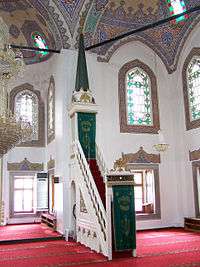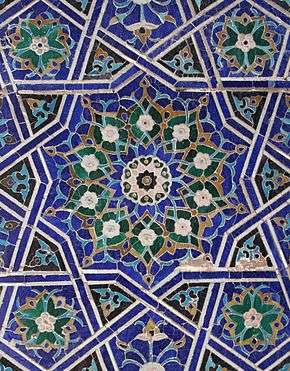Minbar



A minbar (Arabic: منبر, also romanized as minibar or mimber) is a pulpit in the mosque where the imam (prayer leader) stands to deliver sermons (خطبة, khutbah) or in the Hussainia where the speaker sits and lectures the congregation. The word is a derivative of the Arabic root n-b-r ("to raise, elevate"); the Arabic plural is manābir (Arabic: منابر).
While minbars are akin to pulpits, they have a function and position more similar to that of a church lectern, being used instead by the minister of religion, the imam, typically for a wider range of readings and prayers. The minbar, the decoration of which some believe to be part of the sunnah, is usually shaped like a small tower with a pointed roof and stairs leading up to it. In contrast, the prophet Muhammed used only a platform with three steps. There may be a seat at the top. In contrast to most Christian pulpits, the steps up to the minbar are usually in a straight line on the same axis as the seat, as seen in those illustrated here. They also take the preacher higher above the congregation than is typical in churches. The minbar is located to the right of the mihrab, the niche that indicates the direction of prayer (i.e. towards Mecca). The minbar is also a symbol of authority.[1]
In some mosques there is a platform (müezzin mahfili in Turkish) opposite the minbar where the assistant of the Imam, the muezzin, stands during prayer. The muezzin recites the answers to the prayers of the Imam where applicable.
The oldest Islamic pulpit in the world to be preserved intact is the minbar of the Great Mosque of Kairouan (in the city of Kairouan in Tunisia).[2] Dating from the 9th century (at about 862 AD), it is an eleven-step staircase made of carved and sculptured teak wood. Composed of an assembly of over three hundred finely sculpted parts, this minbar is considered to be a jewel of Islamic wooden art.[3]
References
- ↑ Andrew Petersen, Dictionary of Islamic architecture, Routledge, 1996, page 191
- ↑ Muḥammad ʻAdnān Bakhīt, History of humanity, UNESCO, 2000, page 345
- ↑ Minbar of the Great Mosque of Kairouan (Qantara Mediterranean Heritage)
Bibliography
| Wikimedia Commons has media related to Minbars. |
- Lynette Singer (2008). The Minbar of Saladin. Reconstructing a Jewel of Islamic Art. (London: Thames & Hudson).
